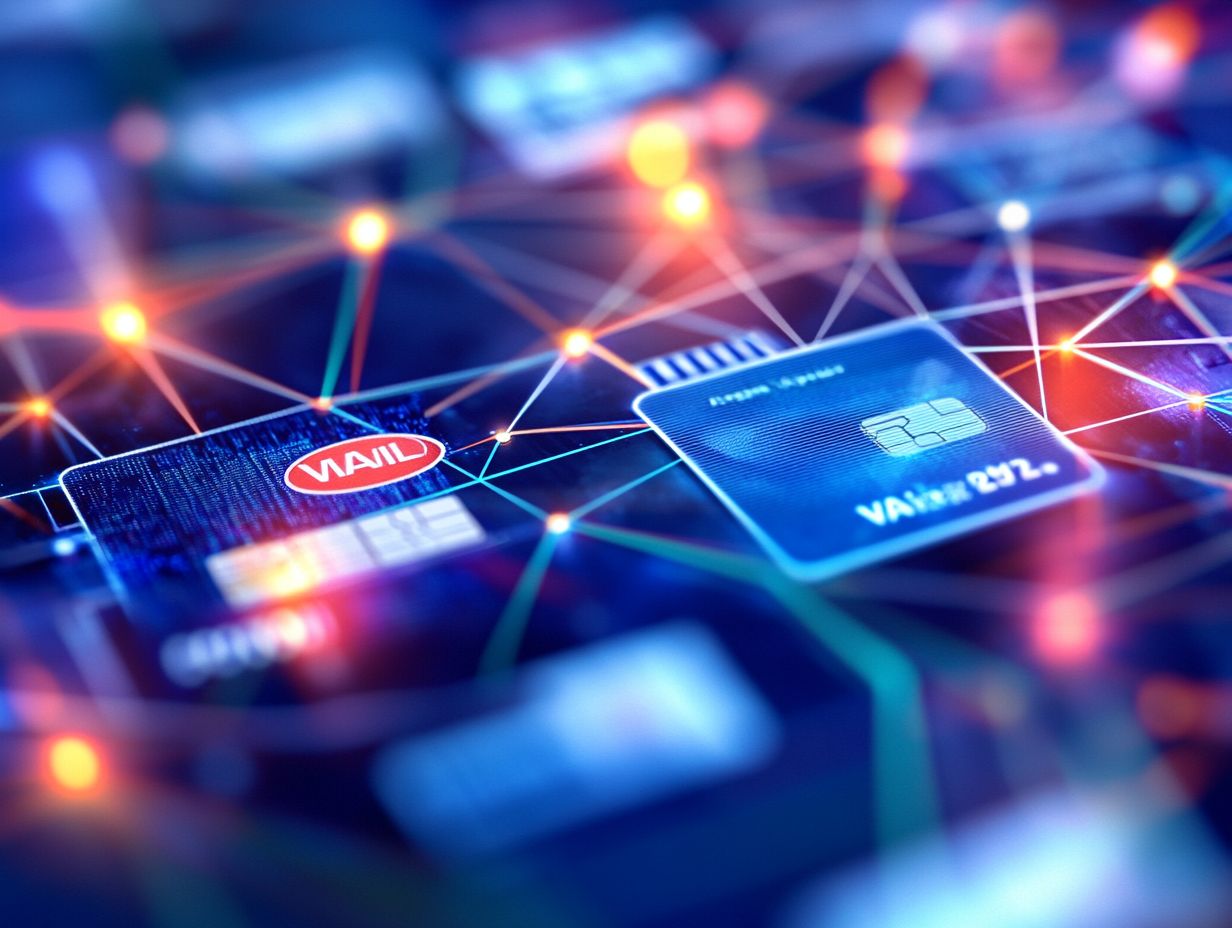What Is a Credit Card Network?
Credit card networks are essential players in today s financial landscape, connecting consumers, merchants, and financial institutions seamlessly.
By understanding what these networks are, how they operate, and the different types available, you ll be better equipped to make informed choices about your spending habits.
From transaction processes and fees to the benefits of convenience and security, this overview covers the essentials of credit card networks and helps you identify the best options tailored to your needs.
Dive in and discover everything you need to know!
Contents
Key Takeaways:

- Credit card networks are the systems that facilitate transactions between cardholders, merchants, and banks.
- The major types of credit card networks include Visa, Mastercard, American Express, and Discover, each with its own unique features and benefits.
- They provide convenience and security, but consider acceptance and fees when choosing the right one.
Understanding Credit Card Networks
Credit card networks are important in processing payments, facilitating transactions between consumers and merchants. These networks form the backbone of credit card payments by linking various financial institutions, including banks that issue cards and those that enable merchants to accept transactions securely.
Understanding how these networks operate is crucial for both consumers and business owners. This knowledge clarifies the transaction process, explains associated fees, and highlights the benefits of credit card use, including digital wallets and fraud protection features.
Definition and Role
Credit card networks are vital for modern financial transactions, facilitating digital payment processing between you and the merchants you frequent, while ensuring that each transaction is secure and efficient.
They serve as a crucial link between consumers and financial institutions, enabling seamless transactions through various intermediaries. By implementing stringent security protocols to protect sensitive information, they help combat fraud and foster trust in electronic commerce.
Their integration with banks and payment processors simplifies the authorization and settlement processes, allowing you to enjoy rapid, hassle-free payments. In an age where online shopping and digital transactions dominate, the significance of these networks becomes clear. They enhance your shopping experience and drive the growth of global commerce.
Types of Credit Card Networks
In credit card payments, you ll encounter two primary types of networks: closed networks and open networks, each playing a unique role.
Closed networks, like American Express, manage the entire transaction process from issuing to acquiring ensuring a seamless experience.
On the other hand, open networks such as Visa and Mastercard offer a broader range of choices, permitting multiple banks to issue cards and process transactions, ultimately enhancing options for you, the consumer.
Major Networks and Their Differences

Major credit card networks like Visa, Mastercard, American Express, Discover, and UnionPay each bring unique attributes to the financial landscape that you should be aware of.
For example, Visa and Mastercard are celebrated for their extensive global acceptance. This makes them the go-to choice for travelers and avid shoppers.
American Express shines with a more robust rewards structure. However, it may not be as universally accepted at smaller merchants due to higher transaction fees.
Discover distinguishes itself with no annual fees for most of its cards and attractive cashback features. These features are particularly appreciated by budget-conscious consumers.
UnionPay is less recognized outside of Asia but is steadily gaining traction, especially among those who frequently visit that region.
These differences in acceptance, fees, and rewards significantly influence your choices as a consumer. They also affect retailers’ decisions regarding which networks to support, as they navigate customer preferences alongside their own cost considerations.
How Credit Card Networks Work
The transaction process within credit card networks involves several essential steps authorization, processing, and settlement. Each step plays a vital role in securing credit card transactions.
When you make a purchase, the transaction is first authorized via a payment gateway. This gateway communicates with your issuing bank to verify your available credit, ensuring everything checks out before any processing fees are applied and the funds are transferred to the merchant’s acquiring bank.
Transaction Process and Fees
Understanding the transaction process and associated fees is vital for you, whether you re a consumer or a merchant managing costs.
The transaction process begins when you swipe your card and culminates in the final settlement between banks. Various fees come into play along this path.
For instance, interchange fees are the fees that banks charge each other when you use a credit card. These can significantly impact a merchant s bottom line, often accounting for a considerable percentage of each transaction.
As a cardholder, you might not realize that these costs can eventually influence pricing and service fees. This affects your shopping experience. Both consumers and merchants can benefit from a clear understanding of how these fees are structured.
Knowing how fees work enables you to make informed decisions and adopt cost-effective strategies in payment processing.
Benefits of Credit Card Networks
Credit card networks offer amazing benefits that can transform your shopping experience! As a cardholder, you gain access to robust fraud protection features, enticing rewards programs, and seamless integration with digital wallets.
The benefits for merchants are equally compelling. Streamlined payment processing enhances efficiency. Plus, increased sales and access to valuable merchant services enable you to manage cardholder transactions with ease.
Convenience and Security

The convenience and security provided by credit card networks significantly elevate your experience, whether you’re a cardholder or a merchant.
These networks deploy cutting-edge encryption technology and real-time fraud monitoring. This enables the swift identification of suspicious activities and safeguards your sensitive information.
By integrating digital wallets, payment processes become effortless. You can complete transactions with a simple tap or click. This further reduces the likelihood of fraud.
Features like tokenization replace your card details with unique identifiers, effectively minimizing the risk of exposure. This seamless interaction enhances your confidence as a consumer and encourages more frequent transactions, benefiting retailers and creating a win-win scenario in the ever-evolving realm of digital payments.
Selecting the Right Credit Card Network
When selecting the right credit card network, it’s essential to consider a few important factors. Think about the issuing bank, any charges associated with transactions, and the specific benefits that major credit networks offer.
Considering these elements will help you choose a network that aligns with your financial habits and needs, allowing you to maximize the perks of your credit card usage.
Factors to Consider
When evaluating credit card networks, consider several key factors, including transaction charges, the issuer’s reputation, and the rewards programs available.
Transaction charges are fees you pay whenever you use your credit card. If these fees are high, they can reduce your rewards or cash back, making what seemed like a great deal much less attractive.
The reputation of the credit card issuer is crucial, as it directly affects the quality of customer service. When issues arise, the responsiveness and helpfulness of customer support can significantly impact your satisfaction.
Rewards programs heavily influence your choices by offering incentives like points for travel, dining, or shopping that suit your lifestyle. These programs enhance the value you get from your credit card, making it a worthwhile investment.
Frequently Asked Questions
What Is a Credit Card Network?

A credit card network is a system that facilitates transactions between credit card issuers and merchants. Think of it as the bridge connecting your credit card to the store where you shop.
How does a credit card network work?
When a customer uses a credit card for a purchase, the transaction is processed through the credit card network. The network verifies the card information, authorizes the transaction, and transfers funds from the card issuer to the merchant.
What are the major credit card networks?
The major credit card networks include Visa, Mastercard, American Express, and Discover.
Do credit card networks charge fees?
Yes, credit card networks charge fees to both the card issuer and the merchant for using their services. These fees vary based on the network and the type of transaction.
What is the difference between a credit card network and a credit card issuer?
A credit card network processes transactions and facilitates communication between the card issuer and the merchant, while a credit card issuer is the company that provides the credit card to the customer.
Are all credit cards part of a credit card network?
No, some smaller credit cards may not be part of a major credit card network and operate on their own, which limits their acceptance at certain merchants.
Discover the best credit card network for you and unlock amazing perks! Research credit card networks that fit your needs and start enjoying the benefits today!






